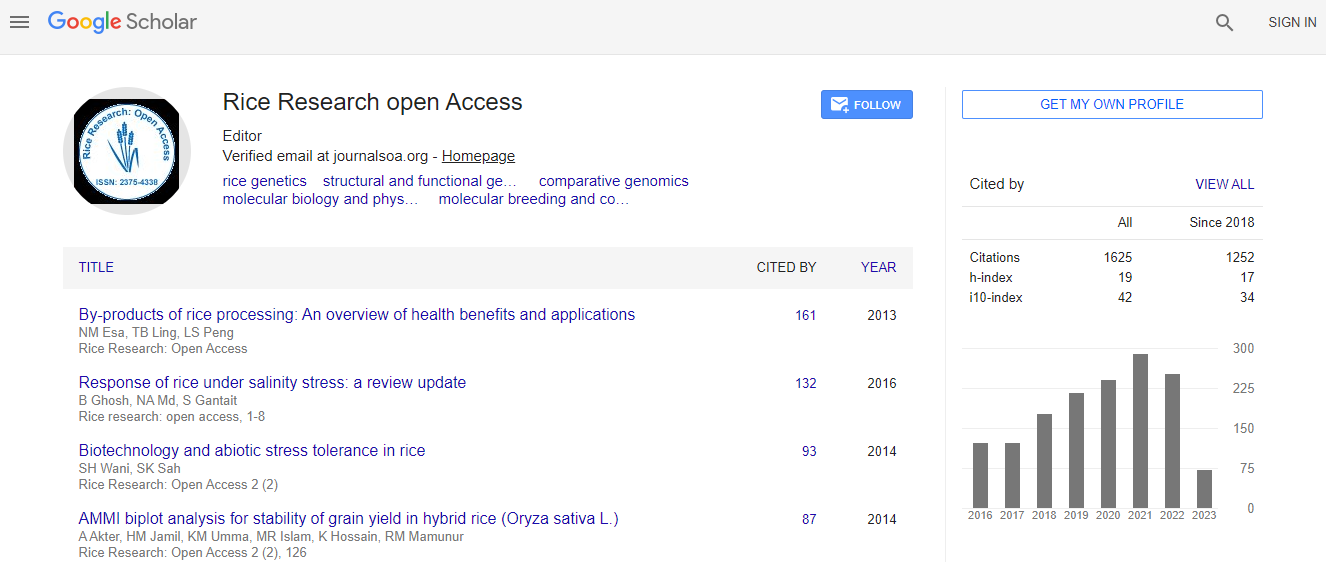Research Article
Characterization and QTL Analysis of Oryza longistaminata Introgression Line, pLIA-1, derived from a Cross between Oryza longistaminata and Oryza sativa (Taichung 65) under Non-fertilized Conditions
Emily Gichuhi1, Eiko Himi2, Hidekazu Takahashi3 and Masahiko Maekawa2*
1Graduate School of Environmental and Life Sciences, Okayama University, Japan
2Institute of Plant Science and Resources, Okayama University, Japan
3Bioresource Sciences, Akita Prefectural University, Japan
- Corresponding Author:
- Masahiko Maekawa
Institute of Plant Science and Resources, Okayama University, Japan
Tel: +81864341214
Fax: +81864341249
E-mail: mmaekawa@rib.okayama-u.ac.jp
Received Date: June 16, 2016; Accepted Date: August 18, 2016; Published Date: August 30, 2016
Citation: Gichuhi E, Himi E, Takahashi H, Maekawa M (2016) Characterization and QTL Analysis of Oryza longistaminata Introgression Line, pLIA-1, derived from a Cross between Oryza longistaminata and Oryza sativa (Taichung 65) under Non-fertilized Conditions. J Rice Res 4:174. doi: 10.4172/2375-4338.1000174
Copyright: © 2016 Gichuhi E, et al. This is an open-access article distributed under the terms of the Creative Commons Attribution License, which permits unrestricted use, distribution, and reproduction in any medium, provided the original author and source are credited.
Abstract
To meet and sustain the food demands of an ever-increasing world population, improving the yield of major cereal crops such as rice is necessary with sustainable cultivation harmonized with the environment. It is useful to utilize wild rice species as reservoirs of novel traits for breeding low-input adaptable (LIA) crops. Oryza longistaminata, a wild species of rice native only to Africa, possesses the vigorous biomass needed under low-input conditions. Thus, a potential LIA (pLIA) candidate, pLIA-1, showing large biomass, tall culm, large panicle with many primary and secondary branches and thick culms was selected from a selfed progeny of the cross between O. longistaminata and Taichung 65 (T-65), a japonica variety, under non-fertilized conditions. The pLIA-1 performance was superior to that of Koshihikari, Norin 18, T-65 and Nipponbare under fertilized and non-fertilized conditions suggesting that pLIA-1’s characteristics might be useful for breeding low-input adaptable varieties. QTL analysis in F2 of the cross between pLIA-1 and Norin 18 detected 31 QTLs for yield-elated traits under non-fertilized conditions. The pLIA-1 allele had a positive contribution in 20 of the QTLs detected. Importantly, many of the QTLs were identified around regions where O. longistaminata chromosome segments were introgressed into pLIA-1. These results suggests that the QTLs detected in the F2 are important to improve modern varieties for adaptability to low-input conditions.

 Spanish
Spanish  Chinese
Chinese  Russian
Russian  German
German  French
French  Japanese
Japanese  Portuguese
Portuguese  Hindi
Hindi 
